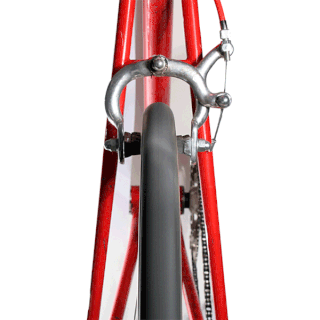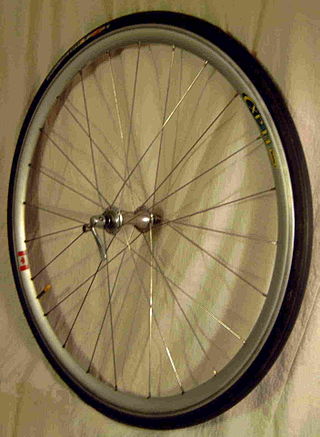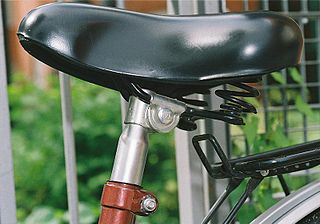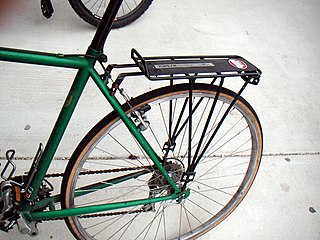
A tricycle, sometimes abbreviated to trike, is a human-powered three-wheeled vehicle.

A bicycle brake reduces the speed of a bicycle or prevents it from moving. The three main types are: rim brakes, disc brakes, and drum brakes.

A bicycle frame is the main component of a bicycle, onto which wheels and other components are fitted. The modern and most common frame design for an upright bicycle is based on the safety bicycle, and consists of two triangles: a main triangle and a paired rear triangle. This is known as the diamond frame. Frames are required to be strong, stiff and light, which they do by combining different materials and shapes.

A bicycle wheel is a wheel, most commonly a wire wheel, designed for a bicycle. A pair is often called a wheelset, especially in the context of ready built "off the shelf" performance-oriented wheels.

A derailleur is a variable-ratio bicycle gearing system consisting of a chain, multiple sprockets of different sizes, and a mechanism to move the chain from one sprocket to another.

A bottle cage is device used to affix a water bottle to a bicycle. Composed of plastic, aluminum, stainless steel, titanium or carbon fiber, it is attached to the main frame of a bicycle, the handlebars, behind the saddle, or, in uncommon cases, the fork. Most modern bicycles have threaded holes in the frame to hold the bottle cage, often called braze-ons even though they may be welded, glued, riveted, or moulded into the frame material. Clamps are necessary on bicycles not so equipped, such as older or less expensive models.

A touring bicycle is a bicycle designed or modified to handle bicycle touring. To make the bikes sufficiently robust, comfortable and capable of carrying heavy loads, special features may include a long wheelbase, frame materials that favor flexibility over rigidity, heavy duty wheels, and multiple mounting points.

A pannier is a basket, bag, box, or similar container, carried in pairs either slung over the back of a beast of burden, or attached to the sides of a bicycle or motorcycle. The term derives from a Middle English borrowing of the Old French panier, meaning 'bread basket'.

The headset is the set of components on a bicycle that provides a rotatable interface between the bicycle fork and the head tube of a bicycle frame. The tube through which the steerer of the fork passes is called the head tube. A typical headset consists of two cups that are pressed into the top and bottom of the headtube. Inside the two cups are bearings which provide a low friction contact between the bearing cup and the steerer.

A bicycle fork is the part of a bicycle that holds the front wheel.

A bicycle seatpost, seatpin, saddlepole, saddle pillar, or saddle pin is a tube that extends upwards from the bicycle frame to the saddle. The amount that it extends out of the frame can usually be adjusted, and there is usually a mark that indicates the minimum insertion. Seatposts can be made of steel, aluminum, titanium, carbon fiber, or aluminum wrapped in carbon fiber.

A fork end, fork-end, or forkend is a slot in a bicycle frame or bicycle fork where the axle of a bicycle wheel is attached. A dropout is a type of fork end that allows the rear wheel to be removed without first derailing the chain.

A bicycle trailer is a motorless wheeled frame with a hitch system for transporting cargo by bicycle. It can greatly increase a bike's cargo capacity, allowing point-to-point haulage of objects up to 3 cubic metres in volume that weigh as much as 500 kg. However, very heavily loaded trailers may pose a danger to the cyclist and others, and the voluntary European standard EN 15918 therefore suggests a maximum load of 60 kg on trailers without brakes.

A bicycle saddle, often called a bicycle seat, is one of five contact points on an upright bicycle, the others being the two pedals and the two handles on the handlebars. The bicycle saddle has been known as such since the bicycle evolved from the draisine, a forerunner of the bicycle. It performs a similar role as a horse's saddle, not bearing all the weight of the rider as the other contact points also take some of the load.

A bicycle basket is a bicycle-mounted basket for carrying cargo, usually light cargo. They are usually used for light shopping duties such as going on daily visits to the shops for fresh bread or milk. Baskets are often mounted on the handlebars and made of traditional basket weaving materials such as wicker and cane or even woven plastic that merely looks like wicker or cane. They can also be made of other materials such as metal mesh. Euroboxes are also used as bicycle baskets.

The stem is the component on a bicycle that connects the handlebars to the steerer tube of the bicycle fork. Sometimes called a goose neck, a stem's design belongs to either a quill or threadless system, and each system is compatible with respective headset and fork designs:

A luggage carrier, also commonly called a (bicycle)rack, is a device attached to a bicycle to which cargo or panniers can be attached. This is popular with utility bicycles and touring bicycles.
Motorcycle accessories are features and accessories selected by a motorcycle owner to enhance safety, performance, or comfort, and may include anything from mobile electronics to sidecars and trailers. An accessory may be added at the factory by the original equipment manufacturer or purchased and installed by the owner post-sale as aftermarket goods. The term Farkle is used within the motorcycle community, originally to denote useful add-ons, such as GPS or other upgraded components. Now also used at times in a humorous or mildly derogatory way to describe bling, such as anodized or chromed parts that add no functionality.

A quick release skewer is a mechanism for attaching a wheel to a bicycle. It consists of a rod threaded on one end and with a lever operated cam assembly on the other. The rod is inserted into the hollow axle of the wheel, a special nut is threaded on, and the lever is closed to tighten the cam and secure the wheel to the fork. Wheels equipped with quick release mechanisms can be removed from the bicycle frame and replaced without using tools by opening and closing the cam lever, thus more quickly than wheels with solid axles and nuts. On the negative side, a quick-release hub renders a wheel more vulnerable to theft and care must be taken to ensure that the mechanism is properly tightened.


















